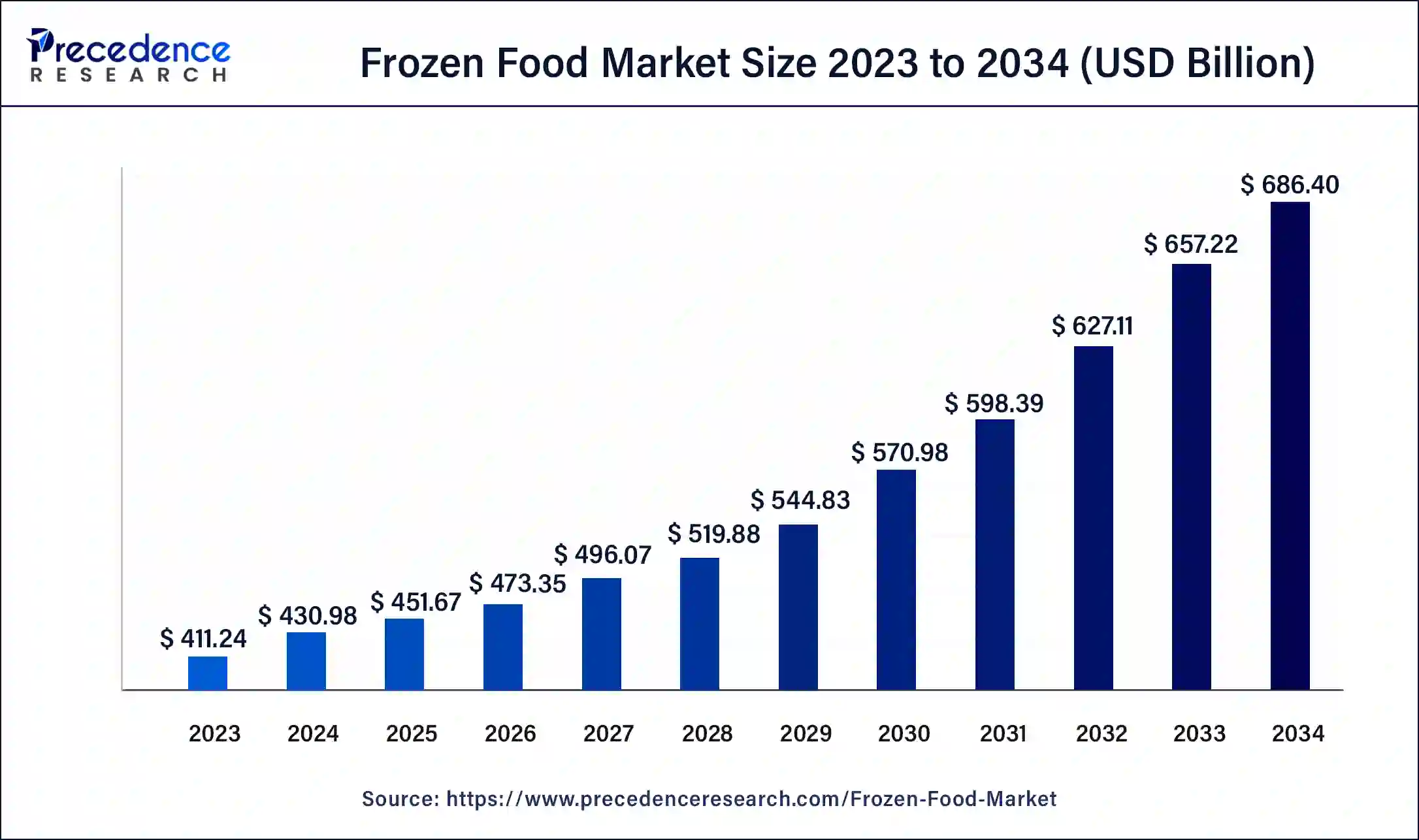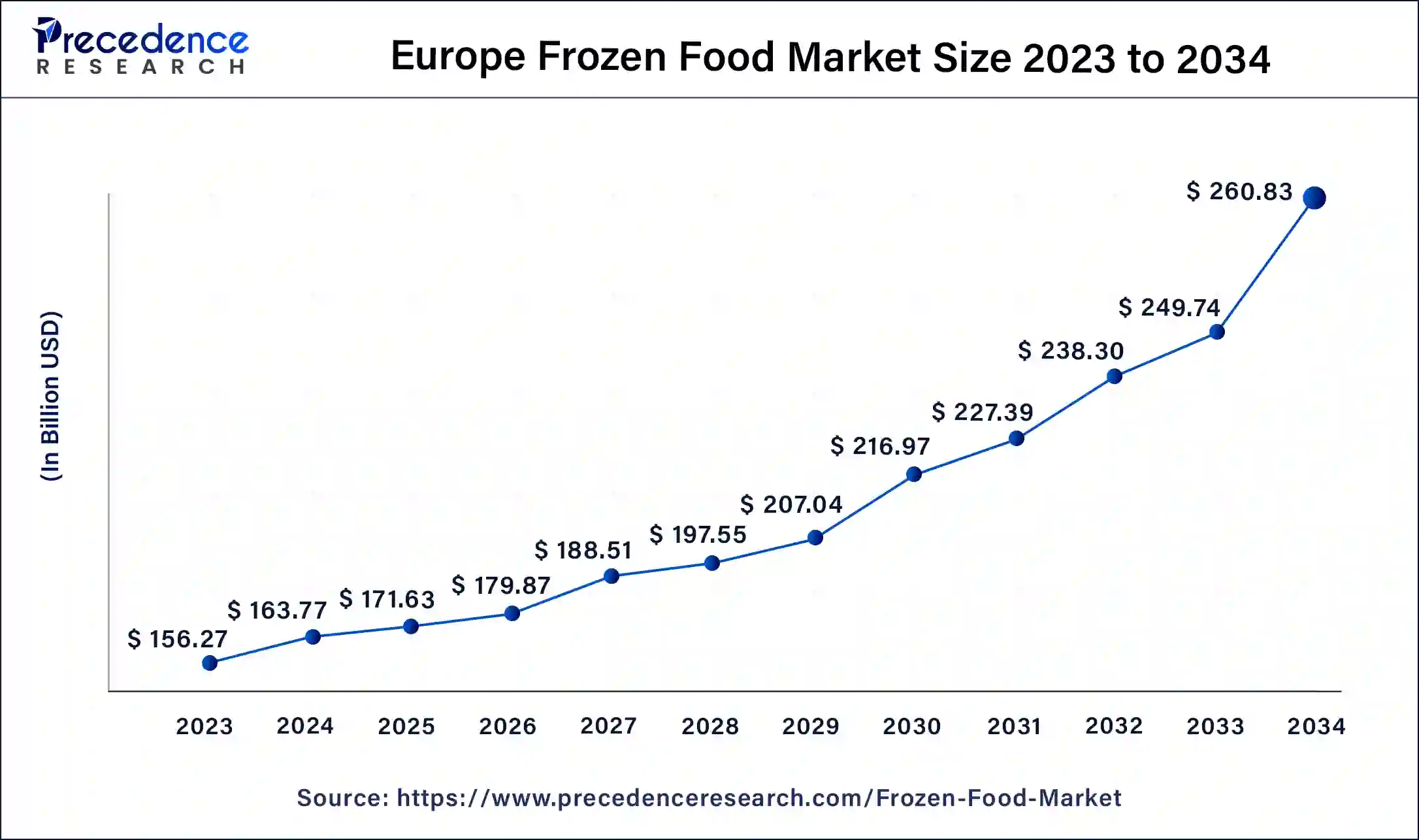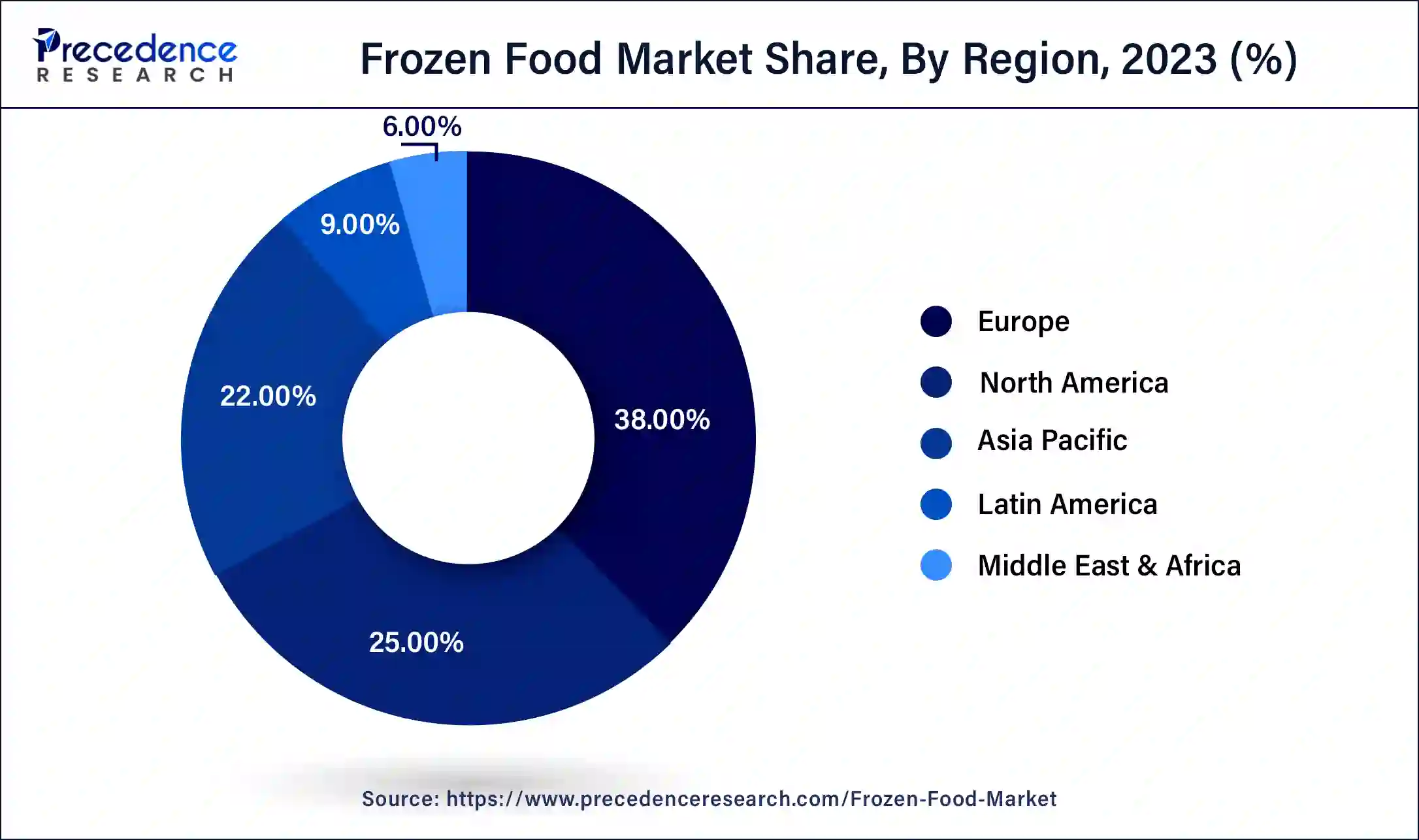January 2025
The frozen food market size was USD 411.24 billion in 2023, estimated at USD 430.98 billion in 2024 and is anticipated to reach around USD 430.98 billion by 2034, expanding at a CAGR of 4.76% from 2024 to 2034.
The frozen food market size accounted for USD 430.98 billion in 2024 and is predicted to reach around USD 430.98 billion by 2034, growing at a CAGR of 4.76% from 2024 to 2034.

The Europe frozen food market size was estimated at USD 152.72 billion in 2023 and is predicted to be worth around USD 253.03 billion by 2033, at a CAGR of 5.2% from 2024 to 2033.

Europe region has accounted largest revenue share of around 38% in 2023. Rising requirement for flexible food options and changing lifestyles in European countries create a significant factor for the market to expand in such areas. The COVID-19 pandemic created significant potential for the frozen foods market in Europe to expand as the pandemic disrupted supply chains for multiple areas where people continued their emphasis over frozen foods. Additionally, Europe’s well established cold chain infrastructure has promoted the growth of the market in past few years. Similarly, people opting for vegan options in food and beverages create another potential for the market to grow.

Depending upon the geography the Asia Pacific region shall have the largest market share for the frozen food market during the forecast. It shall have a CAGR of 9.2% till the year 2033. Countries like India and China shall have the largest market share in the Asia Pacific region. There are many reasons for the growth in these countries. An increased per capita income, increased disposable income and an ever-increasing population in these nations shall make them the largest markets for frozen food. The market for frozen food shall have good growth during the forecast period in the European region. Improved standard of living and increasing need for convenience is driving the market for frozen food in European nations. There's a higher level of consumption of frozen food in many nations. The sentence competition in the frozen food sector makes the food extremely superior in taste as well as in quality. In the countries like United Kingdom Germany and France, there is major growth in the frozen Foods Market.
The global frozen market is increasing as there is increasing FDI in many developing nations. The frozen products market is expected to expand in the near future. Rising demand for convenience food technological advancements in the cold chain market and the developments in retail stores are driving forces for the growth of this market. As frozen food products require less time and effort as compared to cooking meals at home this market is expected to grow during the forecast. Freezing the food slows down the decomposition process and inhibits the growth of bacterial species. The use of preservatives is extremely less in frozen food products as the microorganisms do not grow at a temperature all 15 degrees Fahrenheit which happens to be sufficient in itself to prevent food spoilage. Most frozen food undergoes a mechanical process that uses vapor compression refrigerator technology. Advancements in these technologies have provided devices similar and better technologies for freezing foods. One of the main problems surrounding the freezing method is that the pathogens are deactivated but they do not get killed.
The processed food or the frozen food market is driven by the greater need for food that is convenient to make and eat owing to the busy lifestyle of consumers. In developed as well as developing economies there are dual-income households so ready-to-cook foods are an easy option there's an increase in consumer preference for convenience food as they require a very less amount of time and effort as compared to the traditional cooking methods. Increasing disposable income is one of the factors which largely influences the growth of the frozen food market as there is an increase in the buying power amongst the consumers and they shall help in the growth of the market during the forecast. Latest trends are helping in the growth of the market as online grocery shopping by using various apps makes it extremely convenient for customers to pick their preferred frozen food through these websites. With doorstep delivery options, the market is expected to see growth. The nutritional value of frozen food does not deteriorate hence this is a healthy option. Owing to all of these factors the frozen food market is expected to grow well during the forecast period.
| Report Coverage | Details |
| Market Size in 2023 | USD 411.24 Billion |
| Market Size in 2024 | USD 430.98 Billion |
| Market Size by 2034 | USD 430.98 Billion |
| Growth Rate from 2024 to 2034 | CAGR of 4.76% |
| Largest Market | Europe |
| Base Year | 2023 |
| Forecast Period | 2024 to 2034 |
| Segments Covered | Product, Distribution Channel, Consumption, Type, and Freezing Technique |
| Regions Covered | North America, Europe, Asia-Pacific, Latin America, and Middle East & Africa |
Cold chain logistics is an essential requirement for the storage of frozen food in all nations. Emerging nations are still lacking in the infrastructure of cold chains and are not able to provide safe products to their populace. Though these foods’ shelf life is very long, adequacy of infrastructure leads to the wastage of these food products resulting in a loss to its producers. Investments are very less in developing nations due to the financial crisis, which in turn is hampering the growth of cold chain businesses in this area. However, emerging nations have a lot of lucrative opportunities for funding on account of the changing consumer preferences towards frozen foods and the increasing acceptance of them.
According to Nielsen Market Research Company, frozen and shelf-stable foods were prominent in shopping carts during the COVID-19 pandemic. Consumers stocked up on these food items which helped to reduce the number of trips they needed to make to the grocery store. Nielsen data shows that frozen foods were in the top five food categories with significant sales growth from March to June 2020
While some consumer purchasing habits, such as buying frozen products, may extend beyond the pandemic, other factors may also influence frozen food sales in the future. The impact of the pandemic, and therefore the impact on purchasing power, is not equal among consumer groups. Financially impacted consumer groups may adopt new shopping strategies, for instance, some may opt for more frozen foods over fresh foods to reduce costs. Apart from pandemic impacts, frozen food is one of the most convenient ways for consumers to find meal solutions. In recent years, food manufacturers have given the frozen food category a sharper focus by developing a greater number of tasty and nutritionally-rich products. Given these facts, it is worth getting some insights into frozen food sales trends in Alberta. Such analysis could help Alberta food processors pursue potential opportunities in frozen food manufacturing.
Manufacturers of frozen food are employing technologies like Individually Quick-Frozen (IQF) technology to enhance food quality. Through this technology, food products are placed on a conveyor belt to transfer them to the blast freezer which freezes the product in no time. With this technology, each molecule in the product is frozen well, which is totally inverse of block or bulk freezing. This technology helps in getting an improved quality of products with higher nutritional values. IQF prevents the freezer from the formation of snow by lowering the dryness of the items. Reduced dehydration in the items helps food processing companies to turn up more profit. This technology saves a significant amount of energy, owing to frequency converters deployed over every fan. This setup does not need much refrigeration in an effort to chill off the heat created through fans. This technology provides tender handling and a better division of the items at all phases of the process. It gives an absolute premium item with a conventional look as an end result.
On the basis of the product type, the frozen ready meals segment has generated highest revenue share in 2023. The ready-to-eat meals or the convenient meals segment is expected to dominate the market during the forecast period. In recent years convenient and ready-to-eat meals have seen major growth. The reason that contributes to the growth of the frozen food market is the changing and busy lifestyles of people across the world and an increase in the consumption of frozen foods due to the high amount of disposable income and increased spending power. Even though frozen food is packed food the nutritional value of this food does not deteriorate frozen food is healthy to eat hence even their health-conscious customers wouldn't refrain from buying frozen foods. As there is a high acceptance of these convenient and ready meals which are available through various distribution channels this market segment is expected to grow.
Frozen ready-to-eat meals are complete meals that do not require any other additional ingredients in order to enhance the taste. They are a healthy alternative to fresh food. It is extremely affordable convenient and helps in saving time as the food requires hardly any time to cook. The revenue for ready meals is expected to reach US$ 138.56 billion by the year 2030. Due to the technological innovations in the frozen food industry, these ready-to-cook meals are microwaveable, portion-controlled, and shelf stable. An increased number of women entering the workplace and changing lifestyles is boosting the demand for frozen meals across many nations. Frozen ready-to-cook meals are easy for people who have a hectic lifestyle, people who stay alone and do not want to prepare an entire meal, and also for people who are trying to lose weight.
The online retail segment is expected to have the largest market share during the forecast period. The online retail segment shall have a CAGR of 9% during the forecast. After the pandemic, the sales of frozen fruit through online retails have grown drastically this segment helps in offering convenience to the customers and a variety of options to choose from. The e-commerce platform for food had the greatest growth through the pandemic which had a gain of about 84%. The offline market segment should also have a good market share during the forecast. The technologically advanced infrastructure in various hypermarkets and convenience stores that have provisions for freezing and temperature control facilities will drive the market of this segment during the forecast.
The type segment of the frozen foods market is categorized into raw material, ready-to-eat, ready-to-cook, and ready-to-drink. Among these segments, ready to cook sub-segment is estimated to grow at the fastest rate. Ready-to-cook products are highly suitable for working professionals as they consume less time than conventional ones. The growth of ready to cook segment is attributed to factors such growing populace across the globe, a major shift in the lifestyles of individuals, an increasing number of working women globally, and an increase in disposable income.
COVID-19 Impact Analysis
The impact of the COVID-19 pandemic was positive on the frozen food market. The demand for frozen foods suddenly grew during the pandemic, as these products have a longer shelf life, and thus can be stored for a longer period of time. As the stockpiled by the shoppers ended, there was a shortage of these products in the market. The demand was rising and the supply was not up to the mark due to the lockdowns declared by various governments across the nations. Considering the increased demand, governments allowed the production of edible food across the globe. This has shifted consumer buying patterns drastically.
Segments Covered in the Report
By Product Type
By Distribution Channel
By Consumption
By Type
By Freezing Technique
By Geography
For inquiries regarding discounts, bulk purchases, or customization requests, please contact us at sales@precedenceresearch.com
No cookie-cutter, only authentic analysis – take the 1st step to become a Precedence Research client
January 2025
January 2025
September 2024
January 2025